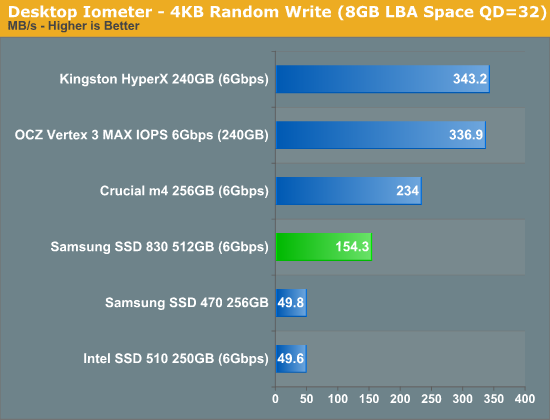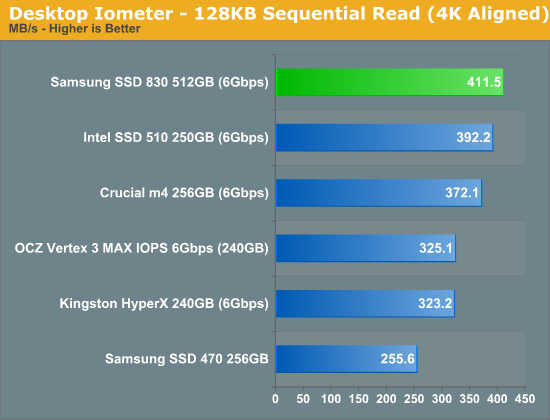The Samsung SSD 830 Review
by Anand Lal Shimpi on September 24, 2011 1:02 AM EST- Posted in
- SSDs
- Storage
- Samsung
- pm830
- Samsung SSD 830
Random Read/Write Speed
The four corners of SSD performance are as follows: random read, random write, sequential read and sequential write speed. Random accesses are generally small in size, while sequential accesses tend to be larger and thus we have the four Iometer tests we use in all of our reviews.
Our first test writes 4KB in a completely random pattern over an 8GB space of the drive to simulate the sort of random access that you'd see on an OS drive (even this is more stressful than a normal desktop user would see). I perform three concurrent IOs and run the test for 3 minutes. The results reported are in average MB/s over the entire time. We use both standard pseudo randomly generated data for each write as well as fully random data to show you both the maximum and minimum performance offered by SandForce based drives in these tests. The average performance of SF drives will likely be somewhere in between the two values for each drive you see in the graphs. For an understanding of why this matters, read our original SandForce article.

Just as we saw in Crucial's move to the m4 it looks like random read speed actually dropped a bit between the SSD 470 and 830. And just as we mentioned before, most desktop workloads don't demand super high 4KB random read performance so if this move was done to improve the 830's behavior elsewhere then it is a worthwhile tradeoff. Even with the drop however the 830 delivers the fastest 4KB random read performance of any high-end drive we've reviewed.

Random write performance has improved tremendously, although it's still noticeably slower than the SF-2281 drives and Crucial's m4. Similar to 4KB random read performance, there are diminishing returns beyond a certain level. Intel tends to have the right idea in how best to deal with random writes: work slower but clean up along the way, vs. write as fast as possible and rely on TRIM/idle garbage collection to improve performance later on. I've become wary whenever I see ultra high 4KB random write performance because it usually means that fragmentation can be a problem over time.
SandForce's numbers are high here because the workload is easily compressible, which is usually the case for desktop random writes as they tend to be table updates.
Many of you have asked for random write performance at higher queue depths. What I have below is our 4KB random write test performed at a queue depth of 32 instead of 3. While the vast majority of desktop usage models experience queue depths of 0 - 5, higher depths are possible in heavy I/O (and multi-user) workloads:

We don't see huge scaling with increasing queue depths from any of these drives really, with the exception of the SandForce solutions. Remember for the SF-2281 extra IO doesn't actually result in more writes to NAND, just a higher compression ratio which results in better performance with very little added work. I suspect SandForce's controllers could do very well in high load enterprise environments as a result. I've been working on an enterprise workload suite to figure that out...
Sequential Read/Write Speed
To measure sequential performance I ran a 1 minute long 128KB sequential test over the entire span of the drive at a queue depth of 1. The results reported are in average MB/s over the entire test length.

Although there are diminishing returns for ultra high random read/write operations on a desktop system, large sequential reads still scale quite well. If you do any amount of large file copying from your SSD to another SSD or file server you'll want to pay attention to these numbers here. Samsung manages to dethrone Intel at the top of our charts here with a very respectable 411.5MB/s.

Sequential write speed is also still very important, again for those large file transfers. Despite the importance of random read/write IO the majority of desktop access patterns are still governed by sequential throughput. For an SSD to truly excel it needs good performance in all four of these categories. Thankfully for Samsung's sake, the SSD 830 delivers.










99 Comments
View All Comments
Out of Box Experience - Saturday, September 24, 2011 - link
Compatability?As far as I am aware, Intel and Samsung were the only drives compatible with XP and every other OS out of the box
Am I wrong on this point?
I believe ALL other SSD's require Partition Alignment for compatability
It would be nice to get an update to see if ANY newer 6Gbps are compatible with every OS out of the box like the Samsung 470 and Intel drives
Is there a compatability list floating around somewhere Anand?
A Google Search turns up no reliability issues from anyone who actually knows what they are doing either
If you want to find hundreds of reliability or compatability issues, just visit the OCZ Forum or go read the Newegg reviews
or go sleep it off
extide - Tuesday, October 4, 2011 - link
EVERY SSD should be 4KB aligned for best performance.Out of Box Experience - Wednesday, October 5, 2011 - link
Intel and Samsung SSD's do not require end user alignmentOnly SSD's that do not have the offset in firmware require alignment
kake - Saturday, September 24, 2011 - link
I like your mic.sequoia464 - Saturday, September 24, 2011 - link
Quite a bit more juice running through them than the other drives - is this partly from the 256 mb cache?tipoo - Saturday, September 24, 2011 - link
Even the most power hungry SSD's don't require any additional cooling. It may look big on the graph, but that's still sucking way less power than most things in your system like the processor, graphics chip, etc. It just won't produce that much heat.sequoia464 - Saturday, September 24, 2011 - link
Thanks, Reason I asked is that My Toshiba based Kingstons seem to run (at least to the touch ) cooler than my both Intels and Vertex2's. (not that they are hot by any means, just warmer).Probably the workload and usage that is at play here - now that I think about it.
name99 - Saturday, September 24, 2011 - link
Different people have different concerns.Yes, if you install this in a desktop box power is not an issue.
If you install it in a laptop, the concern is probably not the thermal load but the maximum power draw. If your laptop is not specced to handle that, you'll find the machine crashing when you do a lot of back-to-back writes.
Same thing if you hoped to use it in a USB enclosure, whether USB2 or 3.
Jaybus - Tuesday, September 27, 2011 - link
Probably a combination of things. Certainly, the DRAM is much larger than what is used by the other drives. Also, notice that this 512 GB version is being compared to 256 GB drives, so right off the bat its flash is taking twice the power as those it is being compared with. This was mentioned in the article. Samsung has not yet supplied a 256 GB version for testing. So I doubt it is a controller issue. Probably just the fact that it has twice the flash.infini - Saturday, September 24, 2011 - link
I don't think Intel is the king of reliability with the 8mb problem of the 320 series. Beenthere can you provide a link with compatibility and reliability problems of Samsug drives?